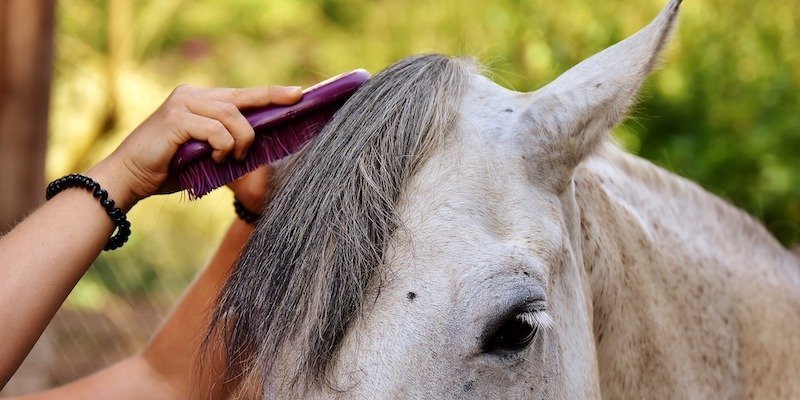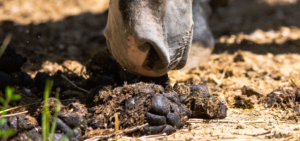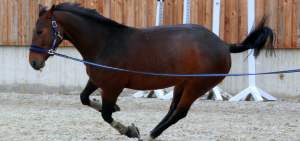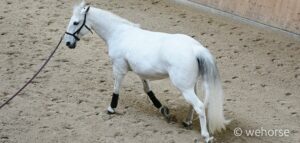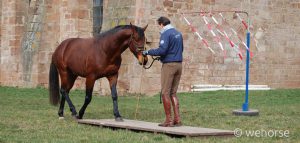There is a unique serenity that one experiences when grooming horses; a certain quiet, a certain calm. For many of us, this can be the most relaxing part of our day. This may also be true of our horses. So, why is grooming horses so important? And why is this experience one so mutually satisfying?
Summary
- Why Should You Groom Your Horse Properly?
- Cleanliness is Godliness
- On Closer Inspection…
- Improving the Overall Condition of the Skin & Coat
- Why is it Non-Negotiable Before Riding?
- Back it Up
- Suck it In!
- How to Take Care of Your Horse’s Feet?
- Companionship and Connectedness
- What Will You Need?
- How to Actually Groom Your Horse?
- Life-Long Love
Why Should You Groom Your Horse Properly?
Of all the interactions we engage in with our horses on a daily basis, perhaps grooming horses is truly the most productive; the most sophisticated. No other task or activity or exercise allows us to complete as many different tasks simultaneously, and incredibly important tasks, at that!
Cleanliness is Godliness
Who wants a dirty horse? Not many. Grooming horses allows us to clean wounds and lacerations, preventing infection. Grooming horses allows us to rid our animals of parasites or assess medical needs and administer proper deworming agents. Cleaning our animals minimizes the risk of contagions and disease. Cleanliness is pretty important. That one’s a no-brainer.
On Closer Inspection…
Grooming horses is a time that also provides us with ongoing opportunities to assess our horse’s wellbeing and overall health. While we are grooming our horses, we allow our hands to trace along our horse’s muscles, his structure, his alignment. We will physically feel swelling or bumps, lacerations or abrasions, some of which may never have been caught by the naked eye.
We will feel our horses react to our touch if they experience discomfort, or we touch a sore or tender area. We may catch bumps or insects plaguing our horse and be more proactive in our approach to battling these infestations. Each of these critical components come under scrutiny when we are grooming our horses and physically interacting with and communicating to them.
Improving the Overall Condition of the Skin & Coat
Grooming our horses also enhances the overall appearance and health of their coats. Brushing removes dead hair and tissues and brings rich oils to the surface of the coat, producing a gorgeous shine and clean healthy appearance. Furthermore, grooming horses aids in their circulation and health, allowing their bodies to function with greater ease while pumping more blood throughout the body and further strengthening the tissues and coat.
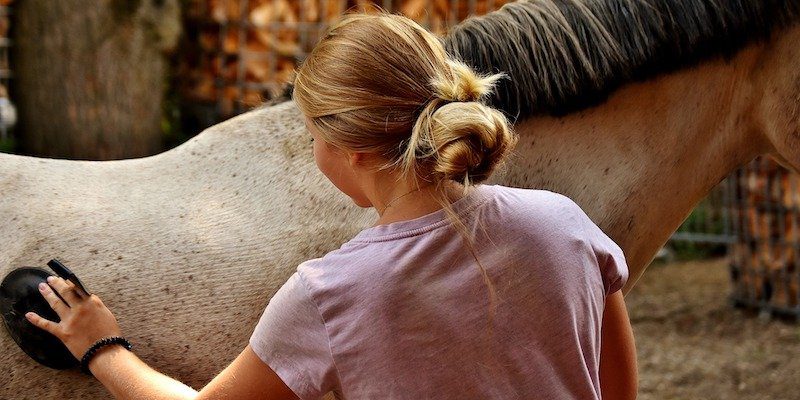
Why is it Non-Negotiable Before Riding?
It is imperative that riders grooming their horses prior to ever touching their tack. This works to prevent dirt and debris from becoming lodged in between the horse’s body and his tack, and serves as a final assessment before equestrians mount up.
Back it Up
There are several key areas you will want to focus on while grooming horses, especially right before a ride. Naturally, the back is important as it is where your saddle will be situated. Ensure that you have removed all dirt and debris before ever placing your saddle on your horse’s back. An overlooked rock or twig will be both painful and distracting to your horse during your ride. Not to mention, the potential for causing a laceration that could potentially lead to infection.
Suck it In!
Another extremely important area to clean and examine prior to a ride is your horse’s girth. This is the area where your girth will be secured, and you will want it completely cleaned and checked prior to girthing up. The same is true of the girth area as the saddle—you want your horse focused and free of any needless stress and pain. It is an incredibly quick task to accomplish while grooming horses, but is nevertheless, equally important.
How to Take Care of Your Horse’s Feet?
Of all the areas of importance on a horse, perhaps the feet are of the greatest. There is no sadness equal to bearing witness to a lame horse. That’s why it is so incredibly important to take care of his feet, especially while grooming your horses! Ensure regular trimmings are taking place, pick out hooves daily and examine to ensure they are of good health, and schedule regular veterinary visits to keep his feet happy and healthy. Your horse will thank you by living a long, full life, and living it right by your side!
Companionship and Connectedness
Like humans, horses benefit from physical contact. In the wild, these social animals regularly engage in contact from the various members of the herd, so being without any contact is a very unnatural thing, indeed. In his canonical studies investigating the role that physical touch and intimacy play in the lives of mammals, Harry Harlow illustrates how important love and affection are in our lives. Grooming horses is an act that provides a mutually beneficial opportunity to express that love and affection while concomitantly accomplishing a variety of other critical tasks.
What Will You Need?
The following list details some of the more important tools you may want to keep in your tack room or grooming box for use while grooming your horses. This list is certainly not exhaustive, but rather suggestive and provides a summation for more of the commonly used tools in the trade:
- Hard brush: For the first step in grooming horses & to remove the initial layer of mud and dust and dirt
- Medium brush: To pick up any loose pieces left after a hard brushing
- Soft brush, or finishing brush: For that final shine and sheen
- Curry Comb: Metallic or rubber, though rubber is far easier on your horse’s coat
- Mane & Tail Comb/Brush
- Hoof pick: Cleaning out hooves, frog
- Sweat scraper: This elongated tool aids in drying your horse after baths
Additional considerations of tools you may want to possess while grooming your horses: Vacuum, hoof polish, coat conditioner, mane & tail conditioner, rag or cloth, or any other tools or materials that you and your horse enjoy!
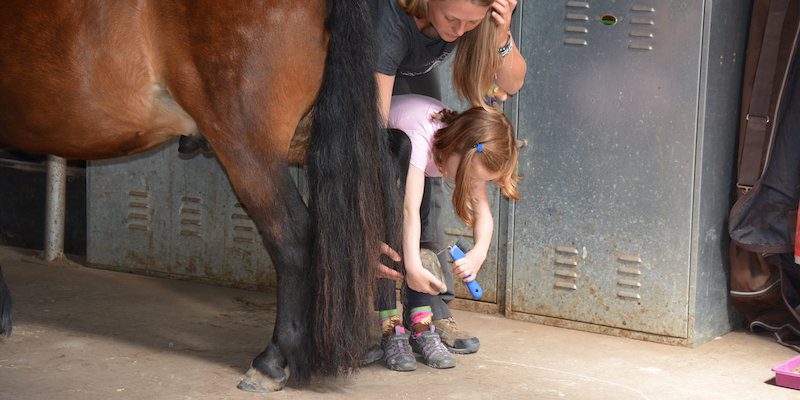
How to Actually Groom Your Horse?
There is no one true way to correctly groom a horse. Everyone has their own habits and preferences, as do our companions. However, there is a general practice that most equestrians adhere to. It will look something like this:
Step 1: Some individuals like to give a general look-over their horses before even beginning. This may include talking to your horse, visually assessing any swelling or other areas of concern and just general petting and interaction. Although it is not technically necessitated, it may not be a bad habit to get into.
Step 2: The Curry Comb: After your greeting and visual assessment, use your curry comb or stiff-bristled brush to begin, removing larger pieces of dirt, dust, and debris, and gently massaging his muscles and coat. Many horses really enjoy this step, though typically, horses enjoy the entire process.
Step 3: After this general cleaning, move on to your medium-bristle brush, or finishing brush if you don’t have a medium tool. If you’re using your medium brush, continue by removing any dirt the hard brush or curry comb left behind and gradually move towards a polish, ensuring that your horse’s coat is free of any debris, looks visually aesthetic, and shines.
Step 4: Finally, comb out his mane and tail, doing so gently. Although horses may not be as sensitive to pulling as people can be, due to fewer nerve endings connecting both mane and tail to his body, it is still best practice to be gentle. Apply conditioner or moisturizer to keep his mane and tail looking fresh and clean.
Step 5: Last but certainly not least, finish by gently and thoroughly picking out his hooves. Some trainers like to begin with the hooves, which is perfectly fine, while others do it last to ensure nothing can become lodged in the feet during the process. There truly is no right or wrong answer, as long as you make sure to clean his feet before taking off.
Life-Long Love
The importance of grooming is not one that can be over-emphasized. Truly, no other activity can be as complex, nor as productive, as the act of physically caring for our horses. Each time we groom, we can physically show them the love and affection we have for them, tend to their physical needs, and assess their overall health. Some may argue that grooming wastes time; is an unnecessary frivolity, but the next time you’re feeling lazy and don’t want to go out to groom your horse, remember what you’re really giving up.

